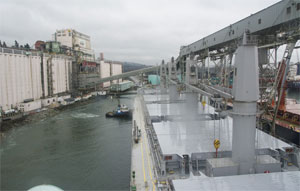Serving the 15,000 miles of convoluted coast in the 655 miles from Brotchie Ledge off Victoria, British Columbia, to Stewart, Alaska, in the north, the BC Coast Pilots have one of the largest territories in the world. The 98 member pilots, who own equal shares in the private company, contract their services to the Pacific Pilotage Authority, a Canadian crown corporation governing pilotage on the West Coast under the Canadian Pilotage Act.
Such a large membership, covering such an extensive territory, presents some interesting logistical challenges when assigning jobs. A pilot may be asked to take a ship from the Port of Vancouver in the south to the Port of Prince Rupert in the north. He may be required to shift a vessel between two piers in a single port. To equalize the workload, the BC Coast Pilots operate with a long job board and a local job board. Jobs on the latter are dispatched out of Victoria, Nanaimo and Vancouver and operate on shorter runs to local destinations. Jobs from the long board would include the west coast of Vancouver Island or ports north of Seymour Narrows on the Inside Passage.
A complex system of assigning jobs assures that all pilots will get an equal mix of work from both the long and local boards. This past February, Capt. Robin Stewart was assigned a “shift” from the local board to bring the bulker Ocean Honesty from English Bay Anchorage 12 in through the First Narrows to the Port of Vancouver’s inner harbor. Vancouver is a busy port for bulk shipments of a variety of products from sulfur to coal and, perhaps most importantly, grain. As a cargo, grain is subject to various delays, from slowing on the long rail lines through the Rocky Mountains from the Prairie Provinces to loading delays due to Vancouver’s heavy rains. As a result it is not unusual to see 14 or more bulkers riding at anchor in the waters just outside the harbor entrance. These ships will, most often, have been brought up from the pilot boarding station at Brotchie Ledge off the southern tip of Vancouver Island. A typical bulker would take about six hours to cover the 80 miles and be a “local board” job for a single pilot. Loaded tankers would require two pilots to provide redundancy over the same route.
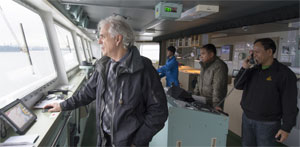 |
|
BC Coast Pilot Capt. Robin Stewart, left, on Ocean Honesty’s bridge while the ship’s master, Capt. Ernesto Carbonel, right, is on the phone. |
The Ocean Honesty job was scheduled for 1430, so Stewart parked his car at the destination, Cargill’s two-berth grain terminal in North Vancouver. He was picked up there by a pilot boat from Tymac Launch, which routinely services ships at anchor in and around the port. At 20 knots, it is a quick run out through the Lions Gate Bridge-spanned First Narrows to the anchorage.
By 1415 Stewart was on the ship’s bridge and had introduced himself to Capt. Ernesto Carbonel. In addition to the usual list of questions on the pilot sheet, Stewart asked the captain, “Have your engines had any trouble with the low-sulfur fuel?”
This was in relation to the recently introduced requirement that deep-sea ships burn only low-sulfur fuels along the West Coast of North America in designated Emission Control Areas. Although Carbonel assured Stewart that there had been no trouble, Stewart later explained that these fuels had, in some cases, introduced a measure of unreliability in response to throttle commands from the bridge. Canada had further decreased the allowable sulfur content in marine fuels from 1 percent to 0.1 percent a few weeks earlier on Jan. 1, 2015.
Stewart explained that there would be two tugs and a line boat to assist at the pier. The captain reported that the ship’s bollards were rated for 64 tons. Because the ship was light, Stewart assured the captain that they would be more than adequate for the docking.
 |
|
The pilot’s laptop computer shows the proportion of Ocean Honesty’s contour, represented by the red image, against the inner-harbor pier. |
“Captain, how many shots do you have out on the anchor?” Stewart asked. This particular anchorage has about 52 feet of water under the keel and the captain replied that he had six shots out.
The BC Coast Pilots have worked with St. John’s, Newfoundland-based NavSim Technology to develop an enhanced navigational system that is independent of the ship’s systems. Upon boarding Ocean Honesty, Stewart placed a small Bluetooth-enabled WAAS GPS device on the ship’s port bridge wing with its round antenna set just where the sign showed the precise distance to the bow and stern. He then entered those two numbers, as well as the bridge wing offset, into his own laptop and set up an additional transponder with the ship’s bridge AIS plug. The first device was a highly accurate AIS that showed the ship’s shape and dimensions on the pilot’s electronic charts. The second device was also Bluetooth-enabled, giving the ship’s AIS information to the computer, including a highly accurate rate of turn. Each of these devices was only slightly larger than a deck of cards and, together with the 10-inch ruggedized Panasonic laptop, had come aboard over the pilot’s shoulder in a compact 2-pound package. The use of both systems gives checks and balances to the information received and greater performance redundancy.
With the electronics deployed and the pilot-captain review completed, Stewart asked the captain to begin picking up the anchor. He then placed a call to “Vancouver Traffic” to inform them of his intention to enter the harbor and proceed to the Cargill Two pier in North Vancouver. Traffic replied that there was an outbound from Cargill One scheduled and an outbound U.S. articulated tug-barge (ATB) was entering First Narrows. “We will be inside the Narrows before the outbound ship leaves and we will meet the ATB outside,” Stewart replied to Traffic.
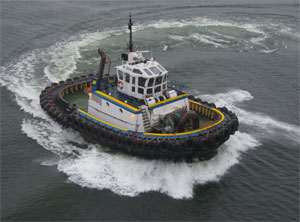 |
|
The 5,400-hp tug Smit Tiger Sun, as it arrived to work Ocean Honesty’s stern quarter. Smit Tiger Sun was one of two azimuthing stern drive boats that assisted the bulk carrier within Vancouver Harbour. |
At 1426 word came to the bridge that the anchor was up about three feet above the water. Stewart asked for “dead slow ahead.” Ocean Honesty was one of 14 ships at anchor. While he gave the helmsman a 010-degree compass course, he pointed out the visual bearing of Navvy Jack Point in the distance below the North Shore Mountains. To starboard, under a threatening gray sky, the high-rises of Vancouver could be seen. Off the starboard quarter was the somber green mass of Stanley Park and ahead the luxury homes that blanket the lower flanks of the North Shore Mountains. Off the port bow the Point Atkinson Lighthouse marked the entrance to Howe Sound or the entrance to Vancouver Port’s Burrard Inlet. To port were the open waters of the Gulf of Georgia and the route to the open Pacific.
At 1439, now making 6.9 knots, Stewart gave a course of 035 degrees to the helmsman to begin the swing into the First Narrows, where the Lions Gate Bridge links Stanley Park with the North Shore. The ATB, having just cleared First Narrows, was 1.2 miles off the starboard bow.
At 1444 the helmsman was directed to 090 degrees, putting the ATB well clear on the port side and lining the ship up for the passage through the First Narrows. First Narrows is the opening to a typical West Coast glacial-formed inlet with a huge area extending beyond the harbor known as Burrard Inlet, which has depths to 700 feet. The inlet shallows to a ledge at First Narrows of only 35 feet at low water. With tidal rises of around 12 feet, this can result in 6-knot currents in the Narrows.
At 1453 Ocean Honesty was into the Narrows and passing under the Lions Gate Bridge. It was an hour and a half into the flood and, with only a 1.5-knot fair tide, the ship was making 9.9 knots. Once through the Narrows, Stewart ordered the helm to 127 degrees, then eased to 125 and 115. This got him clear of the sulfur terminal and vessels around the Seaspan Shipyard. The rain that had been holding off now unleashed its full weight, limiting visibility.
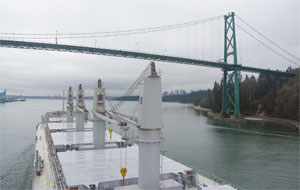 |
|
Ocean Honesty is lined up for passage through Vancouver’s First Narrows, transiting the Lions Gate Bridge. |
At 1500, with the Brockton Point and Burnaby Shoal marking the inner end of the Stanley Park peninsula falling away on the starboard side, the harbor opened up to reveal the city skyline, cruise terminal and container ports to the south. Vancouver Harbour has anchorages as well as piers along both the north and south shores. Additionally there are numerous small vessels like the regular SeaBus ferry to be avoided, not to mention floatplanes arriving and departing.
With a series of rudder commands, Stewart ushered the ship between traffic and anchored ships. It was still making a little over 8 knots when he called for “dead slow” at 1507. Throughout the voyage he had been keeping Carbonel apprised of the docking plans. Now he began to work out the logistics dance that would deal with the two ships, with tugs alongside, waiting to depart. One ship, the bulker Prabhu Parvati, lay parallel to the shore at the JRI grain terminal just to the west of the Cargill pier. A second bulker, Titan, lay on the outside of the Cargill pier. Stewart and the two other pilots determined that those two vessels should stand by while Ocean Honesty worked its way into the narrow slot between the Cargill pier and the shoreline with its towering grain elevators. When Ocean Honesty was secure, Titan would depart and, when it was clear, then the third vessel could go. The priority had to do with the similar route and 180-degree turn that both vessels would have to make on their departure.
At 1507 Stewart called for “dead slow” and a course of 90 degrees that would take the ship directly into the slot for a starboard-side landing. By 1513 the two azimuthing stern drive assist tugs were in position with the more compact, 50-foot, 3,000-hp Tiger Spirit on the forward port-quarter and the 71-foot, 5,400-hp Smit Tiger Sun on the port stern quarter. Both tugs are built to an Al McIlwain design well suited to the tight confines in Vancouver Harbour.
The pilot told the captain of the ship that his crew could ready the lines. At 1515 Stewart gave the command “stop engines,” then at 1517 “dead slow astern.” A series of rudder and engine commands to the ship are interspersed with similar direction to the assist tugs. The digital chart on the pilot’s computer showed the actual shape of Ocean Honesty in red, gradually moving into the slot. Placing a cursor on the bow quarter of the image, Stewart was given the precise distance off the pier, and at 1530 the bow was alongside the pier. Stewart and Carbonel donned rain gear and moved out into the wind and rain on the starboard bridge wing. The ship was still making 1 knot ahead. “Dead slow astern” was followed by “stop astern” with the mate repeating the command coming from the bridge wing. At 1535 the ship slowed to 0.2 knots and the stern neared the outer mooring pylon. At 1537, Stewart told the captain, “We need to go up 55 more meters (180 feet) but I will use the tugs to push us up gentle.”
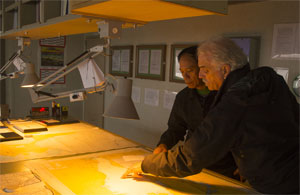 |
|
Stewart, right, confers with Carbonel, left, while reviewing the route through Vancouver Harbour at Ocean Honesty’s chart table. |
At 1550 the lines were up with 41 feet of water under the ship’s keel. The stubby little Tiger Spirit held the bow in with its wash going up onto the riprap below the grain elevators. It is clearly a tug made for the job.
A seemingly routine job is completed but Stewart never treated it as such. As he gathered up and stowed his compact NavSim equipment he explained that ships, many of them tankers, transiting the Second Narrows to refineries beyond the main harbor, are required to use this equipment. “But I like to use it on all jobs,” he explained, “as it keeps me familiar with it and it is an easy-to-deploy asset.”
While piloting is, by its very nature, a technical job, it is also, in most cases, the ship captain’s first encounter with a Canadian. Carbonel had already spent nine months on this voyage and would only be going home for a visit to the Philippines after taking his ship through the Panama Canal to Venezuela and then back to the Pacific. Before leaving the bridge, Stewart thoughtfully took the time to explain the directions to a shopping mall within walking distance of the pier. A fine maritime tradition of pilot and master was extended beyond the job and the pier.

